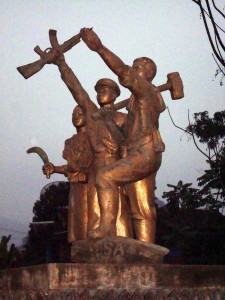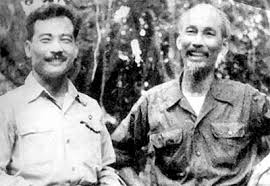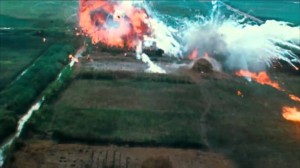The Pathet Lao, antecedent of the Lao People’s Revolutionary Party and the architect of a successful decades-long struggle for socialism, celebrated its 67th anniversary last month. In August 1950, the Laotian section of the Indochinese Communist Party, led by Souphanouvong, formed a separate organization to struggle on behalf of Laotian independence and socialism. The fruit of their struggle is the Lao People’s Democratic Republic, a socialist state of 6.7 million people that has persisted through trial and tribulation for 42 years. Like their closely-allied Vietnamese neighbors, Laotians too have survived French colonialism, U.S. imperialism, isolation from China, the loss of the Soviet Union and the ascendancy of neoliberalism.
What follows is a short overview of Laotian history, the formation of the Lao People’s Democratic Republic in 1975, and the Laotian people’s heroic struggle to win and retain their freedom in an increasingly hostile world.
From Lan Xang Hom Khao to French Indochina
The territory comprising the modern state of Laos assumed its present form as a result of French imperialism, which ruled the territory from 1889 to 1949 following the collapse of Lan Xang Hom Khao ( Kingdom of One Million Elephants and White Parasols). The once-prosperous kingdom had long-since fractured into client states dominated by the powerful Rattanakosin Kingdom in the southwest, known to outsiders as Siam.
In 1862-3 the French Empire annexed neighboring Cambodia and Cochinchina and began sending expeditions into the interior of the continent. Following a short war with Siam in 1893, Laos was annexed, and in 1898 all their Southeast Asian colonies were re-organized into French Indochina. The Lao royalty in Louangphabang retained only nominal autonomy.
By the early 20th century, the French imperialists realized that their main goal in Southeast Asia, conquering Siam, was not possible. The Rattakonsin Kingdom grew closer to the British Empire after losing the war with France. Consequently, the French viewed Laos as a border region to provide security for the far more valuable Vietnamese territories and as a hinterland to provide resources for French-controlled Vietnamese industry near the coast. The French exploited the country for rice cultivation and rice alcohol production, employing an unpaid corvee labor system. By the 1920s, the French also established a tin mining operation and a coffee plantation, though few French residents settled there.
The Formation of Lao National Identity
In the early 20th century, resistance to the growth of colonial institutions forged together an active group of anti-colonial intellectuals that played a key role in creating a new Laotian national consciousness. Militant anti-colonial struggles gave form and focus to the drive for Laotian independence, uniting the various non-Lao ethnicities and cultures in the highlands to their east and south in common cause against French imperialism.
The French founded several colonial institutions in Vientiane, turning a small regional city into the main administrative and cultural center in the country. Colonial institutions such as the law school and Independent Lao Buddhist Institute aimed to create an indigenous petite-bourgeoisie of civil administrators who would run the country on behalf of the French Empire. This petite bourgeoisie, however, began to form nationalist inspirations of their own and would support the drive for independence championed by the Laotian monarchy during and after World War 2, although many of them would later favor cooperation with the West over socialist revolution.
Onerous taxes and extensive exploitation of Laotian peasants as unpaid laborers provoked strong resentment across the country. Uprisings by the spiritual leader Ong-Keo and his successor Ong Kommandam in the south and by the Hmongs in the north frustrated French authorities for decades. Keo and Kommandam’s uprising, called The Holy Man’s Rebellion, forged a united identity for the various hill tribes in the south, who Kommandam collectively called the Khom, and aimed to reassert the prestige and glory they had enjoyed during the past Khmer and Lan Xang kingdoms.
Walking the tightrope to independence: World War II
A coup d’etat ended 800 years of absolute monarchical rule in the Rattanakosin Kingdom in 1932 and created a constitutional monarchy controlled by Tai ethnic nationalists. Renaming the country Thailand, the Khana Ratsadon (People’s Party) led by Field Marshal Plaek Phibunsongkhram, aimed to unite all Tai peoples, which included the Lao, under a single state. After France was defeated and occupied by Nazi Germany in 1940, the rump state, known as Vichy France, ruled by Field Marshal Philippe Petain from Vichy, assumed control over the French Empire’s colonies and allied itself with Germany. With France occupied by Nazi Germany, the Thai government seized the opportunity to invade and annex several provinces in the Mekong valley. The Thai-allied Japanese mediated the peace treaty with Vichy France, using the crisis as an opportunity to establish their own presence in Southeast Asia.
The Laotian, Vietnamese, and Cambodian nationalist groups, including the Lao-nationalist Movement for National Renovation, continued to fight. They forged a greater amount of national unity during the French Popular Front government from 1936-38, which allowed both nationalist and communist parties to operate legally and even to form part of government coalitions. But by 1939, all these groups had been banned.
In February 1941, Ho Chi Minh returned from abroad, and the Indochinese Communist Party adopted a program of national liberation, forming the “League for the Independence of Vietnam” (Viet Nam Doc Lap Dong Minh Hoi, or Viet Minh for short) to fight against both French colonial authorities and Japanese occupiers. Large numbers of Lao freedom fighters joined the ranks of the Viet Minh.
On March 9th, 1945, the Japanese government, in an effort to save a failing situation, directly seized Indochina from the French, imprisoning colonial authorities and forming the different national governments into a constellation of semi-independent states forcibly incorporated into its Greater East Asia Co-Prosperity Sphere. Although Vietnam was broken up, Cambodia and Laos became independent states until the end of World War II, when they were again seized by the French from the Thai monarchy.
The Three Princes
Laotian communists in the Indochinese Communist Party fought with the Viet Minh and gained invaluable military and political experience in the 1940s. Although their “Free Laos Front,” later shortened to Laos Homeland or “Pathet Lao,” was nominally supportive of the monarchist Free Laos government-in-exile, in reality it remained closely allied to the Vietnamese communists.
Ironically, the leaders of the three forces of the Laotian Civil War were all children of Prince Bounkhoung, the last vice-king of Louangphabang.
Of the “Three Princes,” as they are known in Lao history, Souphanouvong is the most famous. He was one of the key leaders and organizers of the Pathet Lao, a close supporter of Ho Chi Minh, and a committed communist. His half-brother Boun Oum was a royalist, and their half-brother Souvanna Phouma was a Western-leaning moderate. Souphanouvong was the only one of the three who was not of full “noble blood;” his mother came from a peasant family.
‘The Hidden War’
The historic Vietnamese victory at Dien Bien Phu in 1954 ousted the French; Vietnam, Cambodia, and Laos won their independence. The U.S. intervened to carve the South Vietnamese puppet state out of the three self-determining countries.
The so-called “Domino Theory” asserted that socialist states encouraged revolutions in neighboring countries. This motivated the U.S. to develop much closer ties with the Thai government and to become more involved in fighting communism in Southeast Asia. Although the American support for South Vietnam in its war against the North and the civil war against the National Liberation Front was well-publicized, by comparison their growing involvement in Laos was repeatedly denied and kept out of the media, resulting in its nickname “The Hidden War.”
Early in the war, American intelligence considered deploying 60,000 troops to southern Laos to support their side of the conflict, even weighing the option of using nuclear weapons. The CIA spent $500 million training and arming tens of thousands of Hmongs on behalf of the Royal Lao government as the communist insurgency in the north and east grew. It is the largest paramilitary operation the CIA has ever undertaken.
Laos was key to the Vietnamese Resistance War Against America, allowing the Army of North Vietnam to ship soldiers and supplies through the eastern side of its territory along what became known as “the Ho Chi Minh Trail.” In addition to their direct involvement in the expanding Laotian Civil War, the Americans waged several bombing campaigns against the Ho Chi Minh Trail, including Operations Barrel Roll, Steel Tiger, and Commando Hunt. Between 1964 and 1973, the U.S. flew 580,000 bombing missions and dropped 2 million tons of bombs on Laos. That is more bombs than were dropped during all of World War 2. Over 50,000 people died in the Laotian Civil War. This had a massive impact on a small country of only 3.5 million, and they continue to die today. Another 20,000 people have been killed since the war ended by stepping on U.S. bombs leftover from the war that never exploded. In September 2016, then-US President Barack Obama pledged $90 million to help Laos find and disarm the estimated 80 million cluster bombs that never exploded. Although he claimed an “obligation” to help Laos, he stopped short of apologizing for US crimes there.
Much of the large-scale poppy cultivation in the region stems from the Civil War era as well. The CIA was one party that trafficked opioid narcotics to support the communities that it was arming to fight the communists, particularly the Hmongs. Major problems with drug smuggling away from populated areas still frustrate the central government, and these are likely to continue while Myanmar, and to a lesser extent Thailand, remain unable to stem the lucrative poppy cultivation and narcotics trades.
Pathet Lao Victorious
When the Vietnamese defeated the U.S. in April of 1975, it forced the U.S. out of the entire region. U.S. support for the Laotian monarchy dwindled. The Pathet Lao seized power in December of 1975, seven months after their Vietnamese counterparts.
The country was renamed the Lao People’s Democratic Republic (Lao PDR), and the Pathet Lao was reorganized as the Lao People’s Revolutionary Party. Souphanouvong was President of the Republic, but was not as active in the Pathet Lao leadership. He retired in 1991 to become an elder statesman until his death in 1995. The Laotian Communists enjoyed the support of a variety of national-front organizations representing the different ethnic minorities in Laos.
Once the war was over, new problems reared their head: Laos had almost no industry upon which to base an expansion of productive forces. The formation of socialist relations of production in the country primarily took the form of nationalization, the collectivization of agriculture and a state monopoly on foreign trade. Political relations with its neighboring countries made economic growth difficult, and as a result of the porous border with Thailand, a prolific black market emerged in Thailand where Laotian farmers could sell their goods. This frustrated the government’s efforts to control capitalist accumulation in the country and to achieve self-sufficiency.
Building Socialism in Lao PDR
In 1976 the military once more seized power in Thailand, closing the border but also stepping up Thai support for terrorist forces in Laos who were attacking collectivized farms, sabotaging production, and assassinating communist officials. At the same time, the deteriorating relations between Vietnam and Cambodia affected Laos. The socialist government of Vietnam was forced to enter into Cambodia to halt the Khmer Rouge’s massacring of Khmer and Vietnamese civilians. Disastrously, China sided with the sanguinary Khmer Rouge, and in a major blow to the unity of socialist states, China invaded Vietnam destroying Hanoi, a city just beginning to recover from 13 years of U.S. bombing. The breakdown of principled international relations left Laos with few friends. By the end of the decade, they were forced to back off from aggressive socialist reforms and permit a partial return of market relations. Although many peasants left collective farms in the 1980s and their land returned to individual management, the state still owns that land and leases it to Lao citizens for as long as 30 years, or to foreign investors for up to 50 years. However, even today 37% of farmland remains unsafe because of undetonated munitions from the war. In a country where 70% of the population is engaged in subsistence or near-subsistence agriculture, this is an enormous drain on Lao’s economic potential.
In 1977 Vietnam and Laos signed a 25-year treaty of friendship, and Vietnamese advisors provided much-needed expertise in government and economic policies. Vietnam and Laos fit together, as the common saying goes, “like lips and teeth.” Laos grew closer to Vietnam as its primary trade partner and only route to the sea. The Soviet Union provided most foreign aid to Laos and especially the Laotian armed forces.
In 1981 the First Five-Year Plan aimed for self-sufficiency, but the perceived slow economic growth of roughly 5% per year was judged insufficient, and the Second Five-Year Plan from 1986-1990 implemented the New Economic Mechanism (NEM), which aimed to slowly integrate parts of the Laotian economy with the world economy without sacrificing its food self-sufficiency. While the capitalist world has remained largely uninterested in Laos, China, Vietnam, and the Democratic People’s Republic of Korea have been the primary investors. By the end of the Second Five-Year-Plan, rice production had doubled and sugar production had increased by 40%. Since 1990 Laos cut the number of people living in poverty in half, while the population has nearly doubled. Despite these advances, Lao PDR remains an oppressed country seeking to overcome its tortured recent past.
The Future of Lao PDR
In recent years the Laotian government focused on the extraction industries, opening new tin and potash mines with the help of China and the DPRK, and gold, silver, and copper mines in partnership with other investors, particularly from Australia. The mining sector only comprises around 7% of the Laotian economy, with the industrial sector contributing 28.6%. Hydroelectric power constitutes an enormous part of the Laotian economy, forming 30% of its exports in 2017. Heavy government investment in that industry began in 1993 and rapidly expanded due to the low population density of the country and the comparative ease with which new dams could be constructed. With Lao PDR already producing far more electricity than it needs, it is poised to become a major supplier of clean electricity to all of Southeast Asia.
Another area of economic growth in recent years has been rubber plantations, most of it in the north near the Chinese border. The area under rubber cultivation is projected to reach 13.8 million hectares by 2018, and much of this growth comes from the demand for tires by the rapidly-expanding automobile industry in China. Many of these plantations are funded by foreign investors but local villages struggle to exert some communal control over the plantations, as is laid out by law.
Lao PDR retains very strict labor rules that reflect the power of its working class. Labor unions exist alongside party and council bodies, and all labor units must have a trade union representative. Workers are protected by these institutions from being fired, and any layoff must be justified in a court. Such justifications must prove that the employer has already sought new employment for the worker, with the worker being paid a termination allowance to support them while they continue to look for new work. Employment is a task the government and labor unions also help with. Labor is restricted to 8 hours a day or 48 hours a week for all trades, with maximum overtime hours limits also set, and with extremely generous paid sick leave, maternity leave, and vacation time.
Despite these protections, the presence of market relations ensures the continued survival of a bourgeoisie in Lao PDR. Under socialism, the class struggle continues but it assumes new forms. The power of the bourgeoisie rests mainly in control over local markets and trade in the highly-decentralized country. However, the control by the Laotian working classes over the commanding heights of the economy and the strict limits on private property keep the Laotian bourgeoisie on a tight leash.
The future of socialism and the Lao PDR are closely tied to the fates of their socialist neighbors. A growing relationship with China and new trade opportunities with surrounding Southeast Asian nations promises economic growth. When we speak of economic growth and capital accumulation, we should never forget to ask the question posed by Lenin: “for whom?”